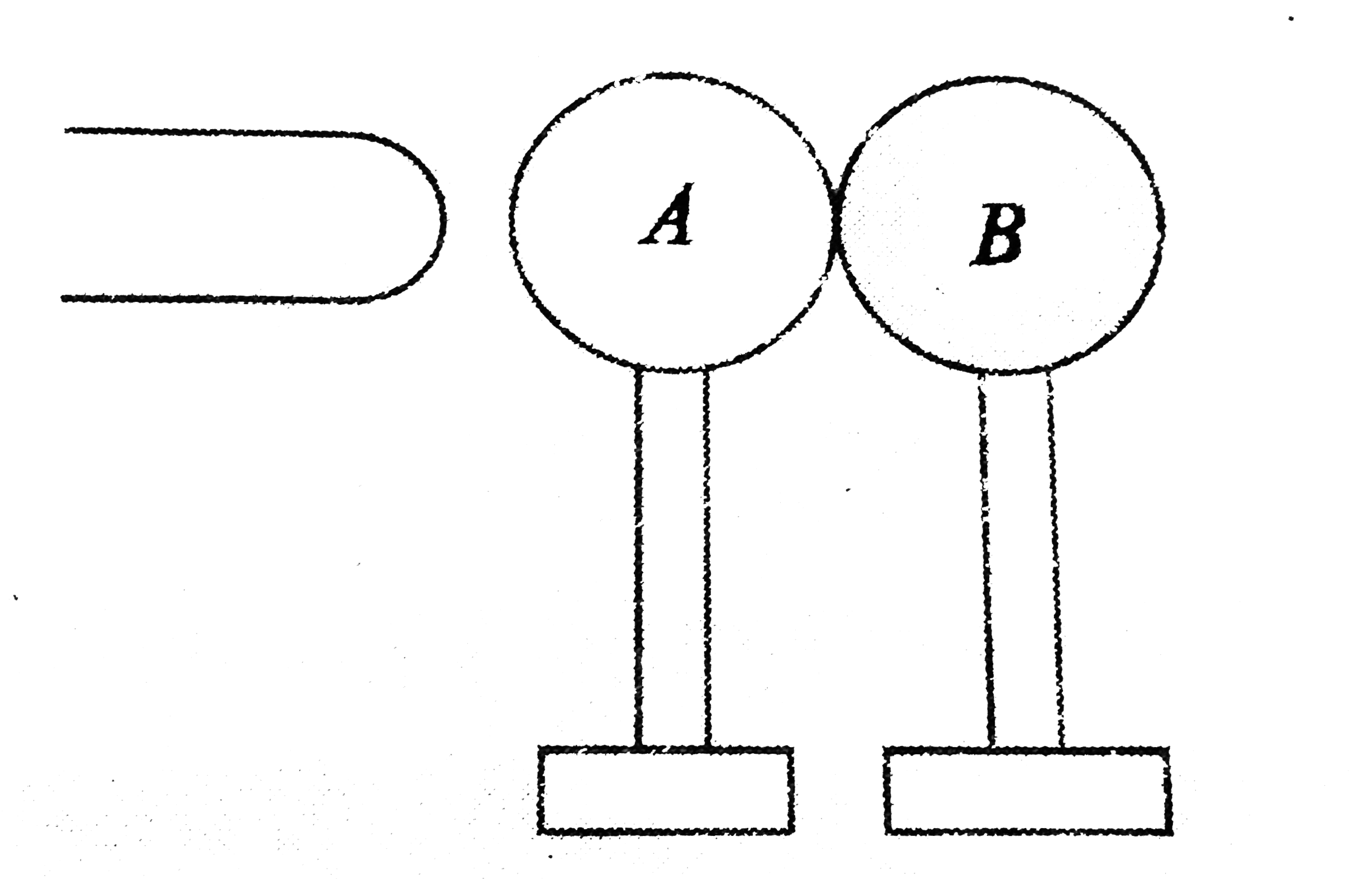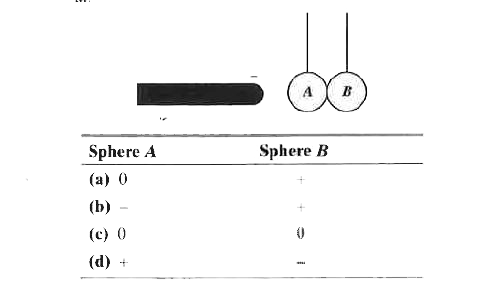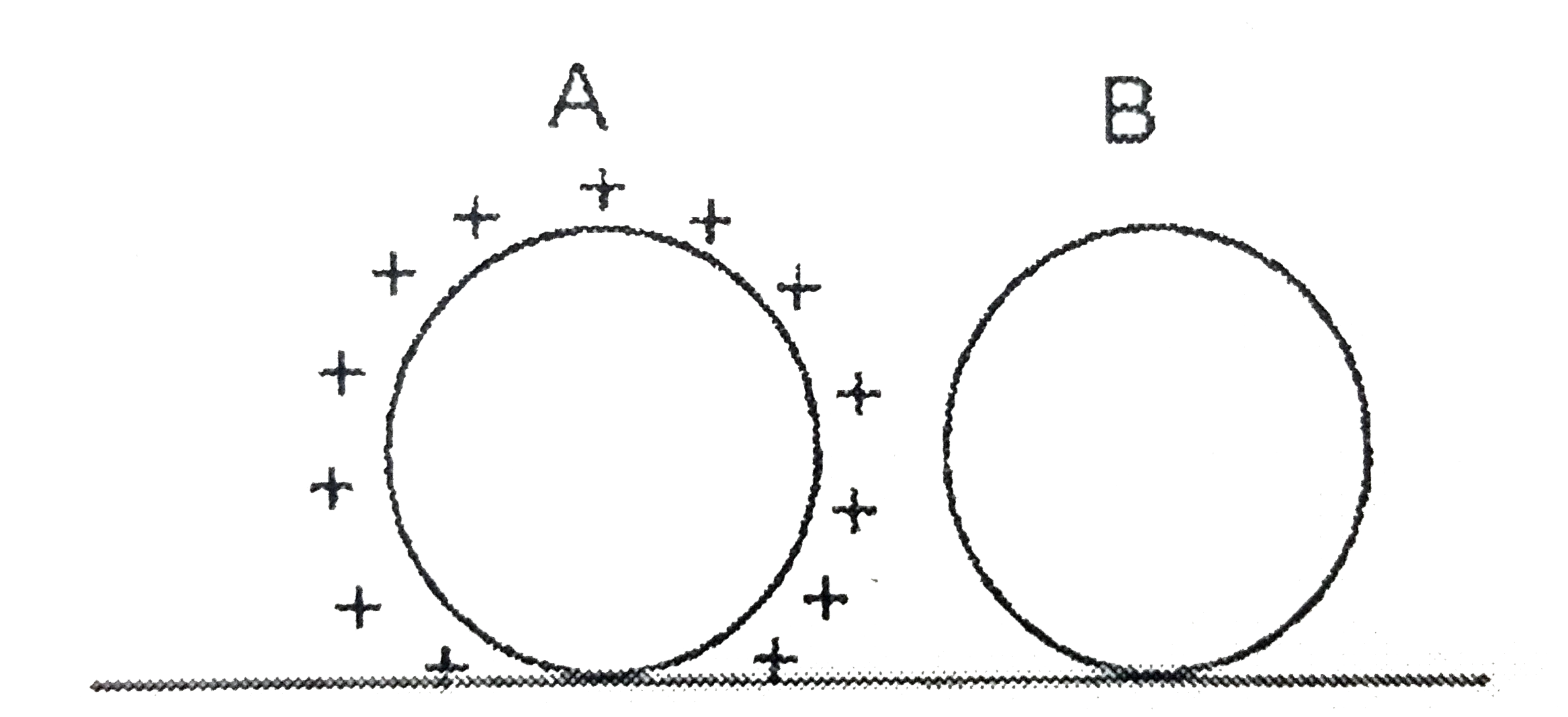The identical metal spheres A and B are supported on insulating stands and placed in contact . What kind of charges will A and B develop when a negatively charged ebonite rod is brought near A ?
A will hae a positive charge and B will have a negative charge
A will have a negative charge and B will have a positive charge
Both A and B will have positive charges
Both A and B will have negative charge
The correct Answer is:A
To solve the problem, we need to analyze the situation step by step:
Step 1: Understanding the Setup
We have two identical metal spheres, A and B, that are in contact with each other and are supported on insulating stands. This means that they cannot exchange charge with the ground or any other object.
Hint: Identify the properties of the objects involved (spheres, ebonite rod) and their arrangement.
Step 2: Bringing the Negatively Charged Rod Near Sphere A
When a negatively charged ebonite rod is brought near sphere A, it will induce a charge separation in the spheres due to electrostatic induction. The negative charge of the rod will repel the electrons in sphere A.
Hint: Consider the effect of the electric field created by the negatively charged rod on the nearby charges in the spheres.
Step 3: Charge Induction on Sphere A
As the negatively charged rod approaches sphere A, the electrons in sphere A will be repelled away from the rod. This will leave sphere A with a net positive charge because there are fewer electrons in that region.
Hint: Think about how charges move in response to an external electric field.
Step 4: Charge Induction on Sphere B
Since spheres A and B are in contact, the positive charge that has developed on sphere A will influence sphere B. The electrons in sphere B will move towards sphere A to neutralize some of the positive charge. This will leave sphere B with a net negative charge.
Hint: Remember that charges can move between conductors that are in contact.
Step 5: Final Charge Distribution
After the negatively charged rod is brought near sphere A:
- Sphere A will develop a positive charge.
- Sphere B will develop a negative charge.
Hint: Summarize the effects of the induction process on both spheres.
Conclusion
When a negatively charged ebonite rod is brought near sphere A, sphere A develops a positive charge, and sphere B develops a negative charge.
Final Answer
- Sphere A: Positive charge
- Sphere B: Negative charge
We have two identical metal spheres, A and B, that are in contact with each other and are supported on insulating stands. This means that they cannot exchange charge with the ground or any other object.
When a negatively charged ebonite rod is brought near sphere A, it will induce a charge separation in the spheres due to electrostatic induction. The negative charge of the rod will repel the electrons in sphere A.
As the negatively charged rod approaches sphere A, the electrons in sphere A will be repelled away from the rod. This will leave sphere A with a net positive charge because there are fewer electrons in that region.
Since spheres A and B are in contact, the positive charge that has developed on sphere A will influence sphere B. The electrons in sphere B will move towards sphere A to neutralize some of the positive charge. This will leave sphere B with a net negative charge.
After the negatively charged rod is brought near sphere A:
- Sphere A will develop a positive charge.
- Sphere B will develop a negative charge.
When a negatively charged ebonite rod is brought near sphere A, sphere A develops a positive charge, and sphere B develops a negative charge.
- Sphere A: Positive charge
- Sphere B: Negative charge
Topper's Solved these Questions
- BOOK - DISHA PUBLICATIONCHAPTER - ELECTRIC CHARGES AND FIELDS EXERCISE - Exercise - 2 : Concept applicator24videos
ELECTRIC CHARGES AND FIELDS
- BOOK - DISHA PUBLICATIONCHAPTER - ELECTRIC CHARGES AND FIELDS EXERCISE - Exercise - 2 : Concept applicator24videos
ELECTRIC CHARGES AND FIELDS
- BOOK - DISHA PUBLICATIONCHAPTER - DUAL NATURE OF RADIATION AND MATTEREXERCISE - EXERCISE -2 : CONCEPT ALLPLICATOR30videos
DUAL NATURE OF RADIATION AND MATTER
- BOOK - DISHA PUBLICATIONCHAPTER - ELECTROMAGNETIC INDUCTION EXERCISE - EXERCISE - 2 : Concept Applicator29videos
ELECTROMAGNETIC INDUCTION
Similar Questions
Figure shows that a positively charged rod is brought near two ucharged metal spheres A and B clamped on insulated stands and palced in contact with each other.

(i) What would happen if the rod is removed before the spheres are separated?
(ii) Would the induced charges be equal in magnitude even if the spheres had different sizes or different conductors?
(iii) What will happen if the spheres are separated first and then the rod is rmoved far away?View SolutionWhat kind of charge is attained by a plastie rod when it is rubbed with wool ?
View Solution
Knowledge Check
- Question 1 - Select One
Two identical metallic spheres X and Y with electrons supported on insulating stands and placed in contact. What kind of charges will be daveioped on X and Y when a negatively charged ebonite rod is brought near X?
AXwil have negative charge and Ywill have a positive chargeBYwil nave negative charge and X will have positive chargeCBoth X and Ywil have postive chargesDBoth X and Ywil have negative charges - Question 2 - Select One
Three metal spheres A,B and C are mounted on insulating stands. The spheres are touching one another, as shown in the diagram A strong positively charged object it brought near sphere A and a strong negative charge is brought near sphere C. While the charged objects remains near spheres A anc C, sphere B is removed by means of its insulating stand. After the charged objects are removed, sphere B is first touched to sphere A and then to sphere C. The resulting charge on B would be-
 Athe same sign but 1/2 the magnitude as originally on sphere A.Bthe opposite sign but 1/2 the magnitude as originally on sphere A.Cthe opposite sign but 1/4 the magnitude as originally on sphere ADthe same sign but 1/2 the magnitude as originally on sphere C
Athe same sign but 1/2 the magnitude as originally on sphere A.Bthe opposite sign but 1/2 the magnitude as originally on sphere A.Cthe opposite sign but 1/4 the magnitude as originally on sphere ADthe same sign but 1/2 the magnitude as originally on sphere C - Question 3 - Select One
Two uncharged conducting spheres, A and B, are suspended from insulating threads so that they touch each other as shown in the figure. While a negatively charged rod is held near, but not touching sphere A, someone moves ball B away from A. How will the spheres be charged, if at all ?
 ASphere A - 0, Sphere :- +BSphere A - 0, Sphere :- +CSphere A - 0, Sphere :- 0DSphere A - +, Sphere :- -
ASphere A - 0, Sphere :- +BSphere A - 0, Sphere :- +CSphere A - 0, Sphere :- 0DSphere A - +, Sphere :- -
Two small metal spheres A and B, each of radius r and supported on insulating stands, located at a distance a(a>>r) from each other are connected by a thin conducting wire. A point charge q is brought near the spheres at distance l(l>>r) on the line joining the centers of the spheres. What are the moduli of charge induced on the spheres ?
 .View Solution
.View SolutionWhat kind of charge is attained by a glass rod when it is rubbed with silk?
View SolutionTwo metallic sphere A and B kept on insulating stand are in contact with each other. A positively charged rod P is brought near the sphere A as shown in the figure. The two spheres are separated from each other , and the rod p is removed. What will be the nature of charges on sphere A and B ?
(##U_LIK_SP_PHY_XII_C01_E08_035_Q01.png" width="80%">View SolutionTwo identical, small metallic shpheres A and B are placed side by side on an insultaing smooth table as shown in the figure. If A is positively charged and held fixed with the table , discuss the motion of B.
 View Solution
View SolutionTwo identical metallic spheres A and B of exactly equal masses are given equal positive and negative charges respectively. Then
View Solution

